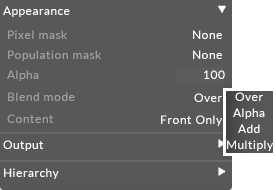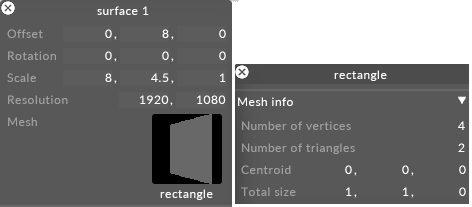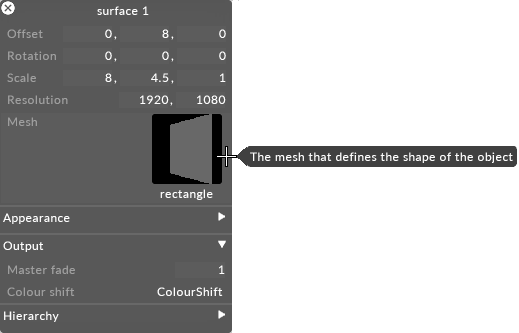Editing objects
Types of object properties
An objects properties can be categorised into four types. Examples of these four types are described below using the example of a Screen object and its editor.

Properties of an object can be categorised into four types: Numeric, Options, Object, Array.
Numeric
With a numeric property, you are asked to fill in a numeric value.
Options
An option property gives you a fixed option list to choose from.
Object
An object property refers to another object.
The example above highlights mesh as an object property. In this instance the mesh property is set to a Rectangle mesh.
Array
An array property is used when an object property points to a list of other objects when you wish to edit it.
In the example above I have left-clicked the mesh property to open the Mesh object library. Notice the object library contains further mesh objects such as Concave and Cylinder objects which can be swapped for the Rectangle mesh object. This is an example of an array property because the Rectangle object points to a list of other objects.
The information below provides a detailed overview on how to edit the four types of object properties.
Editing numerical properties
There are several ways to edit a numerical property:
Adjust using the scroll wheel
Left-click the property name or text field and use the mouse scroll wheel for adjusting the numerical property. Each step of the wheel will add or subtract a step value. Holding down the left Shift key will step ten times faster; holding down the left Ctrl key will step ten times slower.
Adjust using the Arrow keys
Left-click the property name or text field and use the Arrow keys to adjust the values. Each click of the Arrow key will adjust the value by the step value.
Type in the number directly
Left-click the property name or text field and type in a new value to replace the old one.
Type in a numerical formula
Left-click the property name or text field and type in a formula, for example, (1 + 5)*4 . Press Enter to replace the formula with the result.

Change the minimum and maximum limits of a numerical property
Right-click the object property name; this will open up a small editor with four values: min , max , step and damping. By default, when min > max, there are no limits. If min < max, then the numerical property is automatically restricted to the min/max range.

Minimum and maximum limits of a Screen objects Scale property
Change the Step of a numerical property
The step value controls the increment at which a numerical property changes.

Step value of a Screen objects Scale property
Damping
If a numerical parameter is linked to a MIDI surface control, the damping value smoothens the incoming MIDI value to a 0-255 range ( MIDI only ranges between 0-127). The higher you set the damping value, the smoother the conversion will be.

Damping value of a Screen objects Scale property
To see how to link a MIDI control surface to a numerical parameter in Disguise software, see the Expressions section.
Editing an option property
Left-click the option property name or value; this will open up a small menu with available options. Left-click the option you want.

Option properties to decide how content should appear on a Screen object
Editing an object property
To examine or edit the object that the property refers to, right-click the object property name or thumbnail.

Right-clicking Mesh to access an objects properties, in this example a Rectangle
Editing an array property
To swap the object for a different object, left-click the object property name or thumbnail. This will open up an object library. Left-click an object thumbnail to select that object.

Left clicking Mesh to access the Mesh object Library where you can swap an object for a different object
Object property explanations
The Disguise software is able to provide useful explanations on different object properties. To enable Disguise to display explanations of object properties:
-
Hit F1.
-
Hover your mouse cursor over an object. A text box should appear that provides an explanation of that particular object property.

Object properties explained in a useful text box when you hit F1 and hover your mouse cursor over the particular property
-
Hit F1 to exit this mode.
Hitting F1 will also open a Shortcuts menu . For more information on the Shortcuts menu, and to learn all of the shortcuts in Disguise, please see the sub-chapter Shortcuts.
Separator tabs
Object editors may contain elements called separator tabs , which appear as lighter grey bars with a sideways facing triangular arrow (when closed) or downward facing triangular arrow (when open). Separator tabs hide additional editor text fields or command actions, collecting them into sensible groups. Left-click separator tab to open or close it.

Separator tabs dividing the Screen Object editor into Appearance, Output and Hierarchy